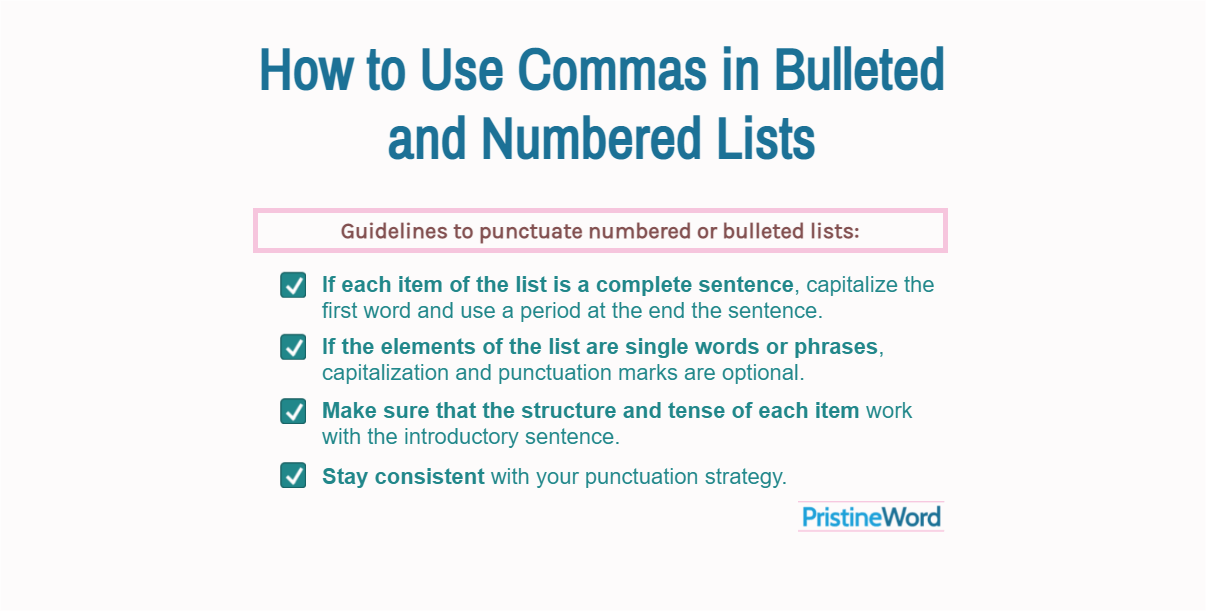If each element of a numbered or bulleted list is a complete sentence, capitalize the first word and place a period at the end. If the elements of the list are single words or phrases, capitalization and punctuation marks (including commas) are optional.
If each element of a numbered or bulleted list is a complete sentence, capitalize the first word and place a period at the end.
Example (correct)
How to marry a millionaire:
- Act as a lady.
- Don't be so obvious.
- Be realistic about your looks and personality.
- Keep them coming back for more.
If the elements of the list are single words or phrases, capitalization and punctuation marks (including commas) are optional.
Example (correct)
The best fruits to eat on a low-car diet are:
- raspberries,
- strawberries, and
- blackberries.
There are no other fixed or definite rules, except to be consistent.
Contents
1. Basic Rules
When listing complete sentences one by one, one per line, preceded by bullet points, numbers, or letters, capitalize the first word of the sentence and place a period at the end.
Example (correct)
These are our community rules:
- Treat others online as you would treat them in real life.
- Do not make personal attacks on other community members.
- Be careful of anonymous complaints.
- Communicate with courtesy and respect.
If each term of the list is a single word or phrase, you can decide how to use capitalization and punctuation marks at the end, including commas, semicolons, or no punctuation at all.
Example (correct)
I would say that these are the toughest sports in the world:
- triathlon
- boxing
- water polo
Use capitalization, however, when using proper nouns (and adjectives derived from proper nouns).
Example (correct)
The most famous bridges in the world are:
- Golden Bridge
- Rialto Bridge
- Tower Bridge
Recommended: How to use commas in simple lists
2. Most Common Ways of Punctuating Bulleted Lists
Lists without punctuation marks are frequently used when listing single words or brief phrases.
Example (correct)
These are the countries with the best health care systems:
- South Korea
- Taiwan
- Denmark
We can also add a comma after each item:
Example (correct)
My favorite sports are:
- golf,
- basketball, and
- tennis.
For a list of longer elements, which follow on from an introductory phrase, you can place a semicolon at the end of each item. In this case, the final item should end with a period.
Example (correct)
There are many ways to have fun, for example, you can:
- play video games with your best friends;
- listen to electronic dance music; or
- cook something new after buying some fresh ingredients at the local farmers' market.
This strategy is particularly useful when using commas in the middle of an item.
Example (correct)
I want you to:
- walk, don’t run, in the hallways;
- be quiet when the teacher is talking;
- respect and listen to your classmates.
Simplicity, however, may be the best option when dealing with very short phrases or descriptions.
Example (correct)
The most popular diets are:
- Mediterranean diet
- Ketogenic diet
- Vegetarian diet
Recommended: Comma after "first", "second", etc.
3. Introductory Sentence-Item Agreement
Use a colon to introduce a numbered or bulleted list and ensure that the structure and tense of each item work with the introductory sentence.
Example (incorrect)
The second item and the introductory sentence do not agree in structure.
If you want to be a good employee:
- Use your best effort.
- Productive.
- Focus on solutions.
Example (correct)
If you want to be a good employee:
- Use your best effort.
- Be productive.
- Focus on solutions
If the list is introduced by "for example", "including", "such as", or any similar expression, do not use "etc." at the end of the list (it is incorrect because these introductory words imply that other examples are being omitted.)
Example (incorrect)
Using "etc." in an example list
Regular exercise has many benefits, for example:
- It is good for your muscles and bones.
- Physical activity can increase your energy levels.
- It can help your sleep quality.
- etc.
We can fix this redundancy by:
- removing "for example" from the introductory sentence while keeping "etc.", or
- removing "etc." from the list.
Example (correct)
Regular exercise has many benefits, for example:
- It is good for your muscles and bones.
- Physical activity can increase your energy levels.
- It can help your sleep quality.
Recommended: Using commas with "etc."
4. Consistency
Consistency is probably the most important quality to keep in mind when using numbered and bulleted lists.
Since different types of lists can take different forms of punctuation, you can use different list styles within a document; however, your punctuation and capitalization should be consistent within a list.
Example (incorrect)
Inconsistent capitalization and punctuation
How can I make my boyfriend crazy about me?
- compliment him
- Become self-confident,
- Tell him you appreciate what he does for you.
Example (correct)
How can I make my boyfriend crazy about me?
- Compliment him.
- Become self-confident.
- Tell him you appreciate what he does for you.
5. Conclusion
These simple guidelines will help you determine how to use commas and other punctuation marks, including commas, when using numbered or bulleted lists:
- If each item of the list is a complete sentence, capitalize the first word and use a period at the end.
- When listing single words, short points, or long phrases, you can avoid punctuation marks, add a comma, or use a semicolon at the end of each item.
- Make sure that the structure and tense of each item work with the introductory sentence.
- Stay consistent with your punctuation strategy.

